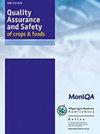The concentration and health risk of potentially toxic elements in black and green tea—both bagged and loose-leaf
IF 5.3
3区 农林科学
Q1 FOOD SCIENCE & TECHNOLOGY
引用次数: 34
Abstract
The concentration of potentially toxic elements (PTEs), including lead (Pb), cadmium (Cd), arsenic (As), zinc (Zn), and copper (Cu), among 160 samples of black and green tea—both bagged and loose-leaf—in Iran was determined using a graphite furnace atomic absorption spectrophotometer (GF-AAS). Besides, the transfer rate of PTEs from made tea into tea infusion was investigated, and the related health risk for consumers was assessed. According to the results, the content of the PTEs is dependent on the type of tea (black or green), the place of cultivation (Iran or India), and the supplied form (both bagged and loose-leaf ). The concentration of Pb, Cd, and As in green tea was significantly lower than black tea (P-value < 0.05). On the other hand, the contents of Zn and Cu in green tea were higher than the corresponding values for black tea. The mean concentration of Pb, As, and Zn in bagged tea samples was significantly higher than those of loose-leaf tea, while the Cd and As levels in Iranian tea samples were significantly lower than the Indian samples. Generally speaking, the mean concentration of Pb, Cd, As, Zn, and Cu were 0.59 ± 0.12, 0.12 ± 0.06, 0.16 ± 0.12, 14.23 ± 4.90, and 11.10 ± 2.49 mg kg−1, respectively. The mean transfer rates of Pb, Cd, As, Zn, and Cu were 7.78, 6.29, 9.27, 12.91, and 13.08%, respectively. The estimated daily intake (EDI) and noncarcinogenic quotient (target hazard quotient [THQ]) due to the ingestion of PTEs besides the carcinogenic risk of As and Cd were considered as acceptable.袋装和散装红茶和绿茶中潜在有毒元素的浓度和健康风险
用石墨炉原子吸收分光光度计(GF-AAS)测定了伊朗160份袋装和散装红茶和绿茶样品中铅(Pb)、镉(Cd)、砷(As)、锌(Zn)和铜(Cu)等潜在有毒元素(pte)的浓度。此外,还调查了茶叶中pte的转移率,并对消费者的健康风险进行了评估。根据结果,pte的含量取决于茶的类型(黑色或绿色),种植地点(伊朗或印度)和供应形式(袋装和活页)。绿茶中Pb、Cd和As的浓度显著低于红茶(p值< 0.05)。另一方面,绿茶中锌和铜的含量高于红茶的相应值。袋装茶样品中Pb、As和Zn的平均浓度显著高于散叶茶,而伊朗茶样品中Cd和As的水平显著低于印度茶样品。总体而言,Pb、Cd、As、Zn、Cu的平均浓度分别为0.59±0.12、0.12±0.06、0.16±0.12、14.23±4.90、11.10±2.49 mg kg - 1。Pb、Cd、As、Zn和Cu的平均转移率分别为7.78、6.29、9.27、12.91和13.08%。除了As和Cd的致癌风险外,pte的估计每日摄入量(EDI)和非致癌商(目标危害商[THQ])被认为是可以接受的。
本文章由计算机程序翻译,如有差异,请以英文原文为准。
求助全文
约1分钟内获得全文
求助全文
来源期刊

Quality Assurance and Safety of Crops & Foods
FOOD SCIENCE & TECHNOLOGY-
CiteScore
4.60
自引率
7.50%
发文量
61
审稿时长
1 months
期刊介绍:
''Quality Assurance and Safety of Crops & Foods'' is an international peer-reviewed journal publishing research and review papers associated with the quality and safety of food and food sources including cereals, grains, oilseeds, fruits, root crops and animal sources. It targets both primary materials and their conversion to human foods. There is a strong focus on the development and application of new analytical tools and their potential for quality assessment, assurance, control and safety. The scope includes issues of risk assessment, traceability, authenticity, food security and socio-economic impacts. Manuscripts presenting novel data and information that are likely to significantly contribute to scientific knowledge in areas of food quality and safety will be considered.
''Quality Assurance and Safety of Crops & Foods'' provides a forum for all those working in the specialist field of food quality and safety to report on the progress and outcomes of their research.
 求助内容:
求助内容: 应助结果提醒方式:
应助结果提醒方式:


